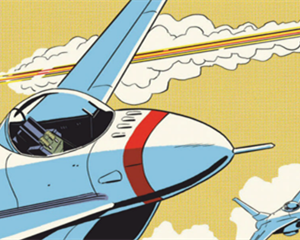Aerial combat
空战
Virtual mavericks
虚拟小牛
Fighter aircraft will soon get AI pilots. But they will be wingmen, not squadron leaders
战斗机很快就会有人工智能飞行员,不过他们只是僚机驾驶员,并非空军少校
Classic dogfights, in which two pilots match wits and machines to shoot down their opponent with well-aimed gunfire, are a thing of the past. Guided missiles have seen to that, and the last recorded instance of such duelling was 32 years ago, near the end of the Iran-Iraq war, when an Iranian F-4 Phantom took out an Iraqi Su-22 with its 20mm cannon.
传统空战中,双方驾驶员拼的是智慧和武器,炮火瞄准将对方击落。这种时代已经成为过去。导向飞弹已经可以做到这一点。据记载,最后一次此类空战发生在32年前,两伊战争接近尾声时伊朗的F-4幻影用它那20毫米的机关炮干掉了伊拉克的苏-22。
But memory lingers, and dogfighting, even of the simulated sort in which the laws of physics are substituted by equations running inside a computer, is reckoned a good test of the aptitude of a pilot in training. And that is also true when the pilot in question is, itself, a computer program. So, when America's Defence Advanced Research Projects Agency (DARPA), an adventurous arm of the Pentagon, considered the future of air-to-air combat and the role of artificial intelligence (AI) within that future, it began with basics that Manfred von Richthofen himself might have approved of.
不过记忆犹存。即便是用计算机中运行的方程式代替物理定律的模拟比赛,空战仍被认为是对训练中的飞行员能力的一个很好的测试。当试验者本身就是一个计算机程序时,情况也是如此。因此,当美国国防部高级研究计划局(DARPA)(五角大楼的冒险部门)考虑空对空作战的未来以及人工智能(AI)在未来的作用时,它会从曼弗雷德·冯·希特霍芬本人可能认同的基础原理开始。

In August eight teams, representing firms ranging from large defence contractors to tiny startups, gathered virtually under the auspices of the Johns Hopkins Applied Physics Laboratory (APL) in Laurel, Maryland, for the three-day final of DARPA's AlphaDogfight trials. Each had developed algorithms to control a virtual F-16 in simulated dogfights. First, these were to be pitted against each other. Then the winner took on a human being.
8月,在约翰霍普金斯应用物理实验室的赞助下,代表着从大型国防承包商到小型初创公司等不同集团的8个团队聚集在马里兰州的劳雷尔市,参加DARPA“阿尔法狗之战”为期三天的决赛。他们分别开发了算法在模拟空战中控制一架虚拟F-16战斗机。首先这些战斗机要相互厮杀。然后获胜者和人类较量。
Dropping the pilot?
将飞行员扔下去?
"When I got started", says Colonel Dan Javorsek, who leads DARPA's work in this area, "there was quite a bit of scepticism of whether the ai algorithms would be up to the task." In fact, they were. The winner, created by Heron Systems, a small firm in the confusingly named town of California, Maryland, first swept aside its seven digital rivals and then scored a thumping victory against the human, a pilot from America's air force, in five games out of five.
DARPA这一领域的负责人丹·贾沃塞克上校表示:开始时我对人工智能算法能否胜任这项任务抱有相当大的怀疑。”事实的确如此。获胜者由“苍鹭系统(Heron Systems)”公司创造,这家小公司位于马里兰州的一个有着奇怪名字的加州小镇。它先是横扫了七个数码对手,然后以五局全胜的战绩完胜人类,即一位来自美国空军的飞行员。
译文由可可原创,仅供学习交流使用,未经许可请勿转载。












